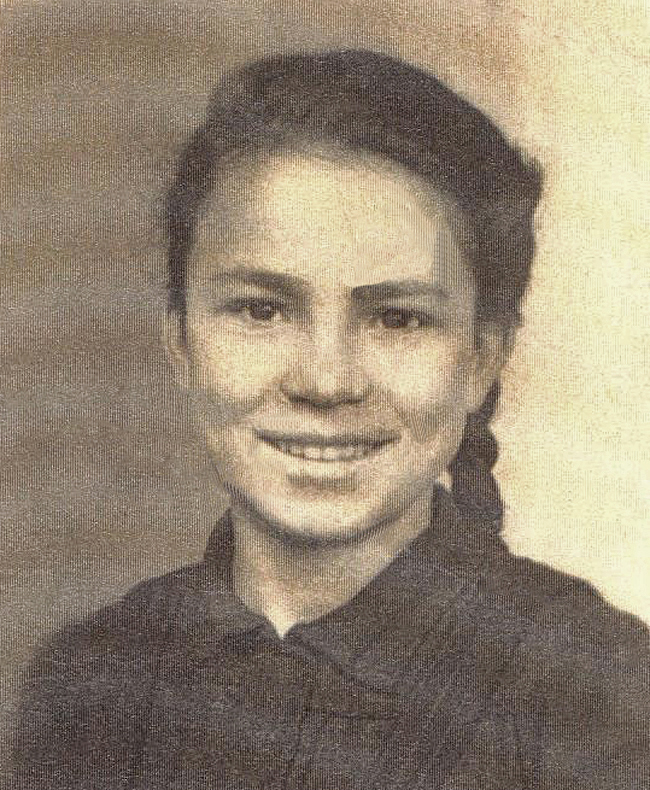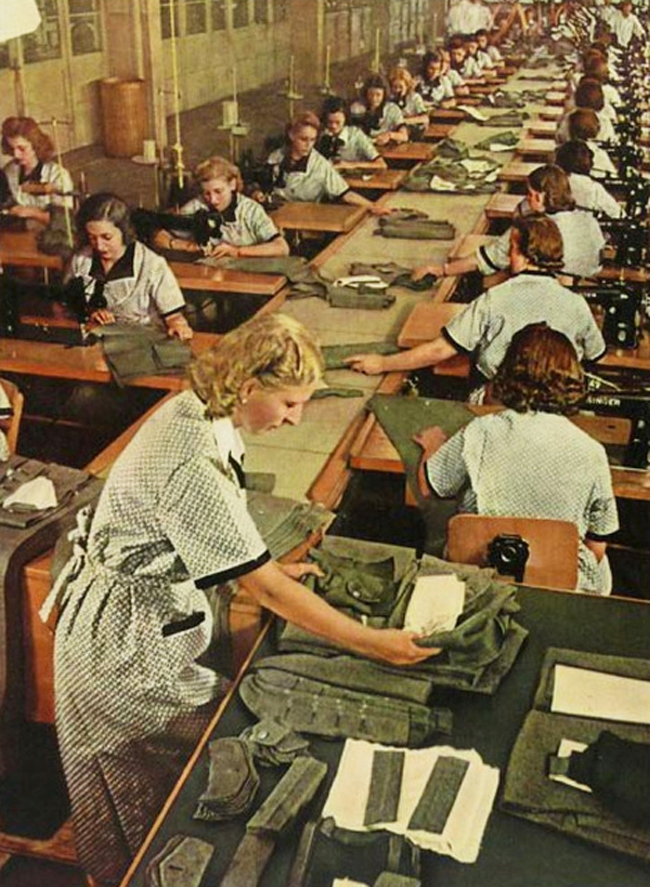By Elinor Florence
My family members, on both my mother’s and my father’s sides, served in the Canadian forces in both world wars. But I also have another connection with wartime: my husband’s family.
He was born in Berlin after the war and emigrated to Canada as a young man. His father Kurt Drews flew with the Luftwaffe, and his mother Gerda Kernchen lived through the bombing of Berlin and its occupation by Russia at the end of the war.
In 2018 Gerda turned 91 years old. She is still living in Berlin. A few years ago I interviewed her on tape about her wartime experiences. Since she doesn’t speak English, the recording was translated by my husband.
Her description of what she experienced during the bombing is very sad. Please note that by repeating her words, I make no comment on the Allied bombing initiative, or the incredible bravery of our young air crews. But their courage in the air shouldn’t detract from the suffering of the civilians on the ground.
This is the first of a two-part series. In this post she Gerda describes her life during the war, when Berlin was bombed 363 times. In the next post titled The Battle for Berlin, she explains what happened when her city fell to the Russians.

My maiden name is Gerda Kernchen (“kernchen” means “appleseed” in German). I was born on December 1, 1927. My brother Heinz was seven years older, and my sister Rena seven years younger.
When the war began in 1939, I was eleven years old and it didn’t affect me too much. Most people in Berlin lived in apartment buildings, but we had our own cottage in a Kleingarten (small garden) area called Wittenau, on the northwest edge of Berlin. My father worked as a welder in a factory, making parts for submarines.
In 1942 I finished my eighth year of school, and applied for an apprenticeship, sewing uniforms for the Luftwaffe, the German Air Force.
I remember how nervous I was when I went for my interview. I knew how to use a treadle sewing machine, but when they asked if I could use an electric machine, I lied and said yes.
They gave me a piece of paper and said: “Show us.” I sat down at the machine and pressed the power and the needle took off like a rocket, sending the paper shooting across the room! But I got the job anyway.
The factory was staffed by girls and women, and a few men too old to serve in the armed forces. My uncle Julius worked there, using a pressing machine, and he watched out for me. It was an assembly line, and everyone took turns doing different jobs on the line. I learned how to sew very well, and I have used that skill ever since.
This photo shows the type of sewing machine that I used.
(Note: These old photographs show a German uniform factory operated by Peek & Cloppenburg, a well-known department store in Berlin. Gerda said the photos are similar to the factory where she worked. Photo Credit: Uniformen und Soldaten, by Curt Ehrlich, 1942).

Here’s the assembly line, showing all the women at their sewing machines.

I worked specifically on the heavy grey greatcoats, as shown here.

My boss noticed how cold I was that winter without an overcoat. To save my pride, he gave me some black fabric used for making Panzer tank division uniforms, and said: “As part of your training, I want to see if you can make yourself an overcoat.” I did, and wore it for several years.
For the first few years of the war, we had an occasional air raid during the night, but nothing too serious. When the air raid warning sounded, our family went down into our root cellar. My father had reinforced the ceiling to make it more secure. Since my older brother was in the army, our family consisted of my parents, and my little sister Rena, and me.
The warning system was very well-defined. We listened to the radio, and it would say: “Bombers coming from Hanover-Braunschweig!” Then we knew that Berlin was the target. We didn’t have electricity, but we had an old-fashioned radio with a battery and a crystal, and we had to move the crystal to tune into the station.
Our neighbours listened to the BBC, even though that was a serious crime. They always knew what was happening before we did. They would go outside and bang their pots and pans, and when we heard the noise we would jump out of bed and listen to the radio, and wait for the official warning.
In November 1943, the first big raid took place on Berlin. I remember it so well, because I was fifteen years old and it was the first time I saw a dead body.
We were in our cellar, and we heard a tremendous crash and the whole house shook. The biggest bomb called an air mine, or blockbuster, had landed in our neighbourhood. The earth was soft peat, so most of the houses just moved on their foundations, but the houses closer to the blast were destroyed.
When we left our cellar, we went to see where the bomb had landed. Then we saw one of the neighbours. He was dead. It was a really frightening sight, because the percussion had mutilated him, and his eyes were hanging out of his head.
It was one of those images I will never forget.
(Note: Two thousand Berliners were killed in this raid, and 175,000 made homeless. The intense bombing campaign lasted until March 1945. By then, half the homes in Berlin had been damaged and an estimated 20,000-50,000 civilians had been killed. This number would have been much higher were it not for the city’s excellent bomb shelters, which often became living quarters for the homeless. This photo shows a bombed street.)

Everyone was so shocked and horrified by the first big raid, because we had been assured that Berlin was safe. My mother said: “We must keep our faith in Herr Hitler. He will protect us!”
My father, who was a first war veteran and had refused to join the Nazi Party, never said a word. I suspect he knew that things were not going well.
From then on, everyone was too frightened to stay at home and we headed to the neighbourhood bunker when the alarm sounded. The bunker had been built earlier in 1943, and it was just two blocks away.
(Even now, when I go to bed everything always goes in the same location including clothes and shoes, so I can get dressed in the dark if necessary.)
(Note: The shelter used by Gerda’s family has been removed, but here is a similar one still in existence. It is now used for storing grain in Berlin.)

Our bunker could accommodate two hundred people. It contained a honeycomb of small rooms, each with a pair of bunk beds, and two benches for sitting. There were also full kitchens and bathrooms. As the raids continued, some people lived there full-time because they had no homes.
Because I was working and it was too disruptive to leave home each night, I obtained a ticket that allowed me to sleep there. I slept in the bunker every night starting in March 1944 until the end of the war. I had to be inside by 10 p.m., and be home at 6 a.m. for breakfast to show my parents that I was fine.
My parents and little sister stayed home. They listened to the radio, and when they heard the warning they made it to the bunker just as the first bombs fell.
When the final alarm sounded, you could already see “the Christmas trees,” the coloured flares being dropped by the Pathfinders to mark the target for the bombers. You could see the searchlights streaming up from the ground, searching for the aircraft. The city was surrounded by a ring of white light.
Outside the bunker, you could hear the bombs whistling as they fell through the air, and then the explosions when they struck, and then see the fireballs rising. Inside the bunker, we could hear the explosions. Once the bunker almost got hit, and we felt it move. We knew if there was a direct hit from a big bomb, we would all die.
The only people inside were women and children and old men. During a raid, everyone was terrified. The mothers were hugging their children, and the children were hugging their mothers. People were crying and praying aloud.
Since my father was an Air Raid Warden, he had to stand near the door so he could run outside to help the wounded as soon as the All-Clear sounded. I don’t have a photo of him, but he wore a helmet like this reading “Luftschutz” or “Air Warden.”

The kids grew up fast in those days. Many of the Air Wardens were old men, or women, or young boys like the one in this old photograph.

The maximum length of a raid was two hours. After it was over, people would go back to sleep. In the morning, I would go off to work although I never knew whether my factory would still be standing. Nobody had telephones then.
When daylight bombing began in March 1944, the factory workers had to leave their jobs during the day and run to the nearest shelter. The alarm would sound, and then swarms of people would start running from all directions towards the Humboldthain bunker.
This was the biggest one in Berlin, five storeys tall, with room for thousands of people. There were anti-aircraft guns on the roof and when they were firing the whole building would shake, which was very nerve-wracking.

After the war they tried to demolish that shelter by blasting, and it wouldn’t budge – it was indestructible. They eventually piled bomb rubble all around it, and turned it into a small mountain in the middle of the city and covered it with trees.
Note: Here’s what Humboldthain bunker looks like today. It’s possible to climb to the top for a good view of the city.

One day there was a daylight raid and we went to the bunker. When we returned to work, we found that our factory was a pile of rubble. There was no transportation, so I had to walk home.
The entire street was on fire – every building on both sides of the street – and the air was so hot that people could stand it only if they walked down the centre of the street.
The phosphorus from the incendiary bombs was running down the outside of the buildings and catching fire. They looked like snakes of fire.
The worst thing was that I could hear the screams of people inside the buildings who were trapped and burning to death. It was terrible. I can still hear their screams when I think about it.
Every apartment building had reinforced bomb shelters in the cellar. The buildings were connected by tunnels, so that if your building was hit, you had a chance of escaping to the next building.
But there were always people who refused to go to the shelters, or couldn’t make it in time. Those were the people who died.
(Note; This is a photo of a Berlin street on fire after a raid.)

There was a very well-organized system in place for dealing with the homeless. The goulash wagons arrived quickly, like the food trucks used in the army. The most important thing for people was food. As long as you had something to eat, you could survive. They would hand out slices of bread with margarine and jam, and noodle soup.
At first people relied on their relatives for a place to sleep, and then an organization would find them a place to stay. Later they converted gymnasiums and schools to sleeping quarters.
The hospitals were still functioning, although the upper floors had been destroyed by bombs, but the care of the wounded continued in the cellars.
There were no official funerals, because there was no material for coffins. Everyone was cremated. There were so many people killed, that there was no time for ceremonies.
You were just trying to survive. You only thought one day ahead.
(Note: This photo shows civilian bodies laid out in a Berlin exhibition hall in August 1944.)

All the restaurants were closed, and there was no dancing or night life. The only things that were still operating were the movie theatres. They continued to make movies throughout the war and showed them right until the last day.
(Note: the theory that German civilian morale would be broken with bombing proved to be false, just as British morale did not weaken during the Blitz.)
We were really kept in the dark as to the progress of the war. It’s hard to believe today how little we knew, about anything. We listened to the radio, but it was all propaganda. About ten times every day, there would be a special bulletin — always positive, announcing some German advance or some victory.
At my workplace, there was a group of women who sat apart, and whenever you went close to them, they would stop talking. I believe now that they were saying negative things about the Nazis and didn’t want anyone to overhear.
We asked the soldiers who came home on leave what was happening, but they only knew about their own small part. They also had to be careful about whom to trust, because any mention of losing the war was treasonous.
My brother was sent to the eastern front, and that’s when we knew things were going badly for our boys. He was in one of the divisions that reached a point 50 kilometres from Moscow, and then he was wounded and sent to hospital. After his convalescence he was sent to Italy, then he came home on leave.
I can only remember him coming home that once, and he had lice — not the small lice we had seen, but huge, ferocious lice! Before a soldier came home, he was deloused. But Heinz had forgotten to include his cap, and there were lice in it. In November 1944 he was sent back to the eastern front again.
The soldiers all said the same thing: they would rather be at the front than be at home, getting bombed. At least on the front, they could fight back. They felt so sorry for us, and worried sick about their families at home.
Starting in 1943, everything was rationed — shoes, clothing, food. We were lucky because we had a big garden and we could feed ourselves. We went door to door and collected used clothing for the soldiers. We wrote hundreds of letters to our soldiers, and sent them dozens of care packages. I remember sending my brother a package of smoked eel!
Being an Air Warden, my father was also in charge of handing out the ration cards for the neighbourhood and I often helped him.
By April 1945, people were becoming very frightened. We knew that the Russians were marching towards Berlin, and there was no hope of salvation. We wanted to surrender to the Americans, who were advancing from the west, but it appeared that the Russians would arrive first.
We began to hear some awful stories about what was happening to the German people in the east as the Russians advanced. During the final weeks, we could hear the big guns firing in the distance as the Red Army drew closer and closer to the city.
The photo below shows German women lining up for potatoes with their ration coupons. (Photo by Robert Capra, Magnum Photos)
Part Two: The Russians are Coming! Gerda describes those terrifying two weeks when the German defenders and the Russian invaders battled it out in the streets. Read it by clicking here: The Battle for Berlin.

* * * * *
MY FAVOURITE VETERANS
This amazing story from Gerda Drews, along with twenty-seven other original stories from Wartime Wednesdays, are available in book form. For more info, check out the book cover titled My Favourite Veterans: True Stories From World War Two’s Hometown Heroes, at the bottom of this page.
Thank you for reading this post. Don't forget to subscribe!
